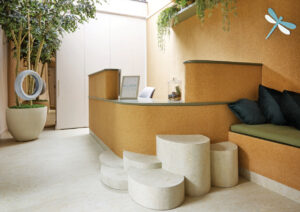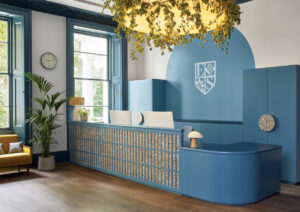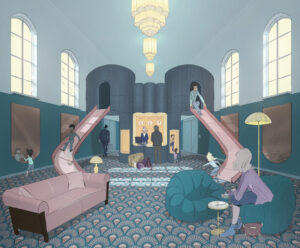James Gavigan, Co-founder and Creative Director at House of Kin, explores why hospitality spaces should consider what they classify as ‘family friendly’ and how designers can implement subtle changes to ensure the design is accessible to all ages.
What do Pixar Animation Studios and the luxury family hotel market share? Surprisingly, more than you may think. Pixar in the ’80’s wasn’t just making movies – it was disrupting a market. Below the surface of its films was a form of invisible magic that casted a spell and pulled you back for more.
The pioneering studio told compelling animated stories that engaged the whole family, tapping into deep emotions with unique narratives, memorable characters and immersive experiences. The stakes were high, the investment significant, but their vision was crystal clear and paid off when Disney bought Pixar for $7.3 billion. It’s that same incredible feeling you want when you walk into a space – to have an emotional reaction that creates an indelible imprint, and leaves you utterly speechless. Too often, luxury hotels rely on their guests – both young and old – to use their imagination to create those kinds of memorable moments. Traditional family spaces can be clichéd, uninspiring, or focused entirely on children and not the wider family.
 So, what does it really mean to be ‘family friendly’? Let’s toss out those complimentary children’s nights, mediocre kids clubs and the predictable teepee in the corner. Surely we can do better than that.
So, what does it really mean to be ‘family friendly’? Let’s toss out those complimentary children’s nights, mediocre kids clubs and the predictable teepee in the corner. Surely we can do better than that.
It’s about making a bold statement. We’re talking one-of-a-kind spaces that don’t just catch the eye but offer immersive experiences that get all the family wanting to explore. The crème de la crème of family resorts deliver not just comfort, but unforgettable adventures that stick with you long after you’ve unpacked your bags.
When you see it from this lens, building ‘family friendly’ spaces involves more than just standard amenities or a cookie cutter approach. It’s about designing extraordinary, wow-factor experiences that leave a lasting impression.
House of Kin builds worlds where families and children sit at the core of what we do. Over the past decade, we have pioneered award-winning interactive family interiors for “the original family members club”, Maggie and Rose, schools and private homes. We’ve observed the industry’s global evolution and are now actively weaving these new threads into the fabric of family hospitality.
Our journey has not only deepened our understanding of the industry, but also refined our passion for reimagining the familiar. We’re excited to share a few elements designed to create family friendly spaces with impact:
 Playful Interactive Features:
Playful Interactive Features:
Forget cartoon wall graphics and primary colour plastic toys in a corner. Find a sweet spot between chic hotels and being ‘Disneyfied.’ Imagine a sculptural slide in the reception area, not just for decoration but as a key visual focus of the room. Connecting all elements of the space, and most importantly, entertaining children while parents relax with a coffee or cocktail. It’s about integrating playful, thoughtful moments that define the space and give it a unique identity.
Accessibility:
Accessibility shouldn’t feel like an afterthought or a compromise. Designing with families in mind means naturally creating inclusive and accessible spaces. For instance, a lowered check-in area or a series of staggered steps can make children feel involved right from the start, enhancing their experience from the moment they arrive.
Durability:
Family-friendly environments need to withstand the toughest of treatments, much like a mediaeval fortress! Maybe that’s why castles make great hotel conversions? When it comes to interiors, durability, doesn’t have to mean bland furniture and finishes. With innovative materials and a team of creative minds, we craft spaces that are both durable and visually delightful with colour, pattern and texture.
Sensory Elements:
Managing sensory overload, like the cries of babies or toddler tantrums, is a challenge in family settings. By considering our youngest guests through sensory-driven design, we can alleviate some of these stresses. Touchable materials like cork walls, sound-absorbing seating pods, and biophilic elements like daylight and plants not only soothe but also enrich the guest experience.
Align with the hotel brand values:
We can’t emphasise enough the importance of creating something which truly visually represents your overarching brand values. For example, if sustainability is number one for you, show it beautiful from the front door, don’t just write about it in a brochure. When brand values are seamlessly integrated from a design perspective, the customer’s experience is based on their senses, it is incredibly subtle but always there.
Can you picture it?
When I get my sketch pad out I imagine something like this

We must understand that luxury family resorts captivate by showing, not just telling their story. Being part of the action is more fun than reading the book! Think Pixar – dare to be bold and stand out from the crowd.
Despite tight budgets and challenging times, the luxury hospitality market continues to innovate and invest in new experiences. Recently, we’ve seen a huge surge in clients eager for a fresh perspective.
Instead of striving to lead the industry, perhaps our goal should be to find and express our own unique voice, telling a story that resonates deeply with the whole family. This new approach will not just redefine your hotel space, but the magic that unfolds within its walls.
House of Kin tells stories.
Pixar tells stories.
What’s stopping you from telling yours?



